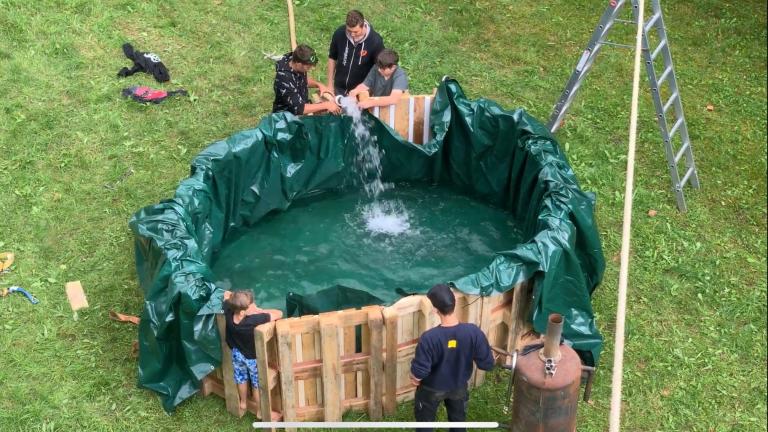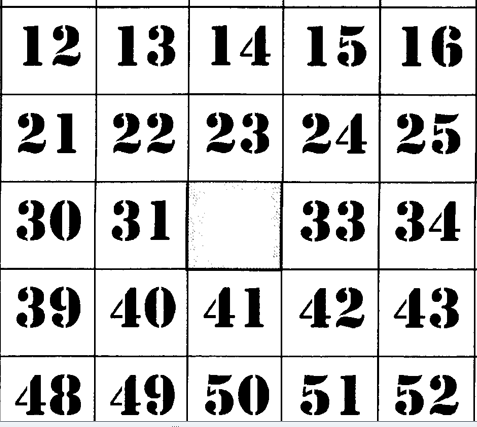A night game for at least 12 (optimally 20) 8-12 year olds where participants need to pay close attention and where a fun mix of action and tactics is created that experience shows is really fun for kids and leaders.
The PDF file is an even clearer version of these rules.
General
- Number of players: Calculated for 20 participants (playable from 12 participants).
- Age: 8-12 or 12-18
- Form: Night game
- Developmental-psychological goal: Strengthening community
- Pedagogical value: Cooperation, perception
Game target
The goal of the game is for your team to bring two of each of the 5 types of
into their own ark, after the animals have been lured with food.
food. Listening to sounds and acting strategically are especially important.
action are important.
Preparation (General)
- Define arks (bases) for teams, making sure that the fetched animals cannot be blown away, e.g. with transparent cover
- Define playing area (about the size of a soccer field)
- Mark out safety zone and first aid station in the middle of the playing field and staff with paramedics + game leader
- Divide participants into four teams, 4 teams of five for 20 children.
Preparation (material)
- Small animal figurines/origami animals/paper slips with pictures of the different animals: 16 pieces of each of 5 animal species (80 pieces), e.g. sheep, pig, whale, peacock, duck
- 5 animal sounds (like the attached sound files)
- 5 wireless speakers (music boxes) and 5 smartphones
- prepare on which the animal sounds can be played
- and distribute these speakers around the play area
- 5x16 animal food, e.g. apples (-> sheep), carrots (-> pig), bundles of grass
- (as algae -> whale), rope pieces (as snakes -> peacock), wild garlic bundles
- (herbs -> duck)
- 44 glow sticks + replacements (in 5 colors, 11 per color)
- 4 (cloth) bags (for the animals / food)
- Prepare first aid kit
- Barrier tape to mark the play area
- 4 transparent foils or boxes as arks (in safety zone)
People who do not play
- Game leader(s)
- 5 leaders, each hiding near a speaker (a smartphone each) and carrying 4 of each type of animal except one (explanation follows). (Leaders sell 4 species of each animal and the food for the species they do not sell).
- 1 leader(s) to visit the posts on the field and return exchanged food and surplus animals from arks to the respective leaders.
Story
- Noah wants to test how skilled his family is at handling animals. Therefore, he sends his wife and his three sons with their teams to lure animals to the ark. Each team has its own gathering place and its own little ark for the animals.
- Alternative story: Peter sends 4 of his co-workers to get some of the animals that Christians may now eat (according to his vision on the roof) (and others as well), each to their own stall.
- Alternative story: A circus director needs animals for the show, the children have to get them.
Rules
- Flashlights are prohibited!
- There are 4 teams. Each team member gets a glow stick in the team color on both wrists to distinguish the teams.
- The teams must try to bring 2 of each type of animal into their ark. Animals can only be attracted with the appropriate food.
- The game leader, who stands in the middle by the safety zone, is responsible for ensuring that teams can only deliver collected animals to the ark when the entire team is present.
Playing field:
Animal habitats:
On the playing field there are 5 places where you can find the animals you are looking for. Near the animal sounds there is a leader or a leader where food can be picked up and animals can be attracted. The animals are always changing their habitat, so sometimes in one place you can hear one animal and then another.
Safety zone:
Around the arks (which are located in the center of the playing field) there is an area where carriers may not be attacked.
Chuck:
- Only the food for a certain type of animal can be collected from each leader.
- The leaders have hidden themselves around their box. This means that you can find a leader by listening to the animal sounds. (Note: The same animal sound does not always come from the loudspeakers, it changes regularly).
- Important: Each team is only allowed to carry 1 food at a time.
- Important: Each food must always be kept in the bag.
Animals:
- Animals can be obtained from the leaders. With the appropriate food, the team must run to another leader. The animal that can be heard can be lured with the appropriate food. For this, the food is given to the leader. In return, the team receives the appropriate animal from the leader. If, for example, a pig can be heard coming from the leader's box, the team can exchange pig food (carrots) for a pig. If after some time the animal sound changes, one may exchange the now audible animal (and no other).
- If a team finds a leader and changes the animal to be heard during the swap, they may still finish swapping.
- Important: All animals must also be kept in the bag at all times (except for animals brought to the Ark and secured there).
- Important: One may carry several animals at once.
Roles in the team:
1st role: The carrier
Each team has a carrier who carries the bag. Whoever is the carrier may change, but the bag may only ever be handed over, never thrown / discarded.
2nd role: The poacher (optional, see under "Variant")
Within each team (once at the beginning of the game) one player is determined as poacher. He is marked with another bend light. The poacher may catch (touch) carriers from other teams and may then try to steal something from the bag.
- This is played scissors-rock-paper. If the poacher wins, he may choose one of the animals carried or the food (if the poacher's team does not have any) to give to the carrier of his own team.
- While a team is playing scissors-stone-paper with another team, it may not be attacked by other poachers.
- After the scissors-stone-paper game, a team may not be attacked for 3 seconds (for this, the team that wants to attack counts down slowly from 3, meanwhile the other team may run away).
- While a team is trading at a leader, it may not be attacked, but immediately as soon as it walks away, it may attack again.
- The poacher may never be the carrier.
Behavior in the team and in contact with other teams:
- Teams must always run around as a group to get animal food, get animals, attack other teams, bring animals back to the ark, and so on.
- If two teams attack each other and the poachers touch the carriers at the same time, they play scissors-stone-paper in parallel and the winner may choose something from the bag of the opponent, as the bag was filled at the time of touching (so it is not allowed to steal the just captured directly again). Otherwise, the poacher who caught the carrier first gets to play and he and his team are temporarily safe.
- Non-poachers are also allowed to prevent other poachers from getting to the carrier.
Victory and evaluation:
- The team that is the first to bring 2 of each animal species into its ark wins.
- If a team has more than 2 animals per species, it does not bring anything to the team (a maximum of 2 animals of each species count in the scoring at the end).
Variant(s)
For a group of children up to the age of 12, the role of the poacher can be omitted. This makes the game calmer.
With the choice of distances, the game can be slowed down and decelerated.
Playing
The game ends either after a given time (1 h / 1.5 h),
or after the first team has collected 2 pieces of each animal species.
Content may be automatically translated. Help improve the quality of the translation with your editing!



